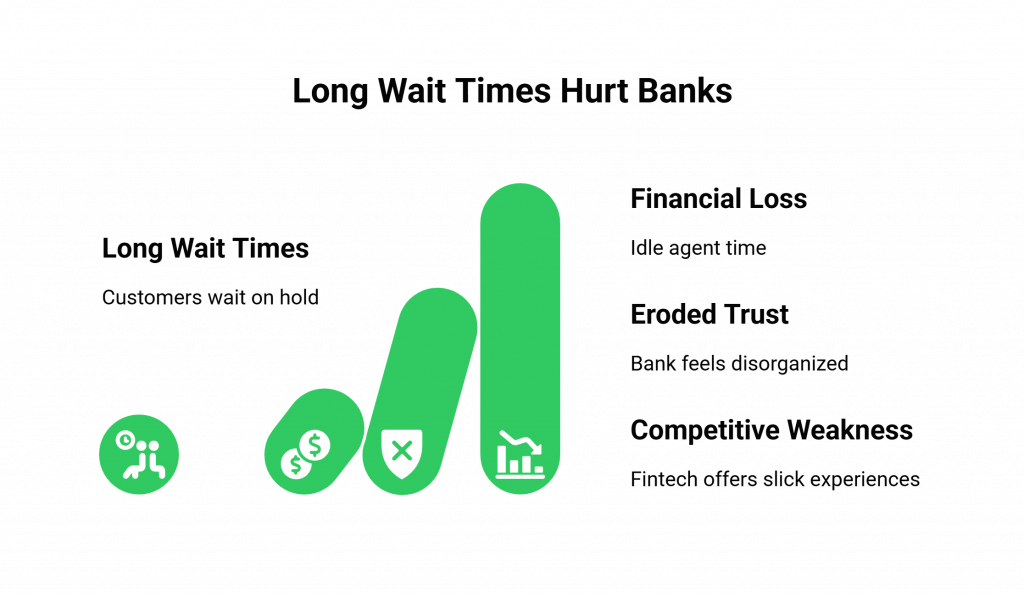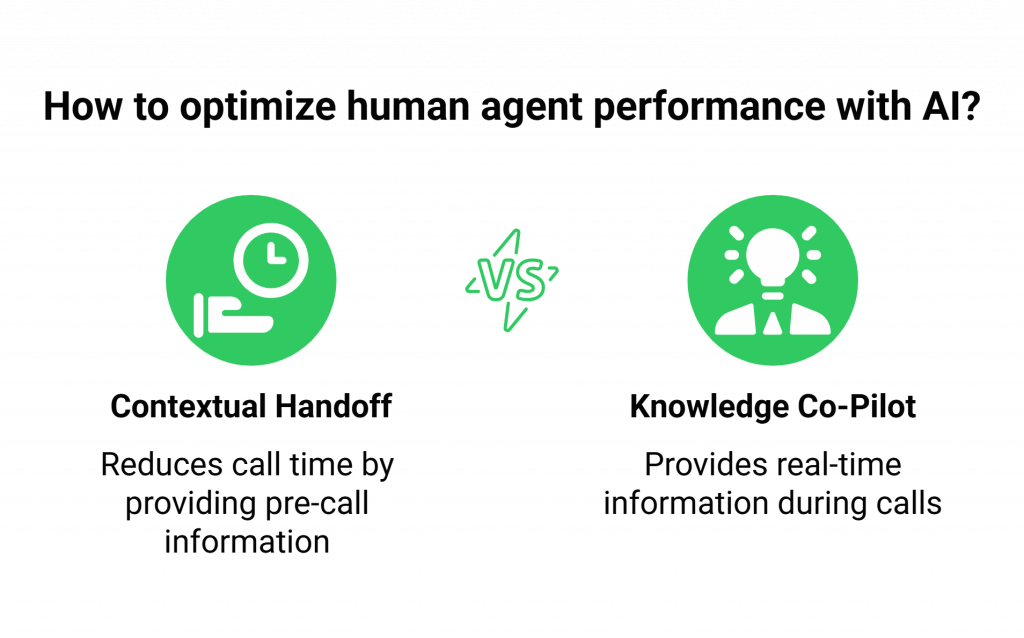Trust is the ultimate currency in the banking system. But in the digital age, a new factor has become just as critical: time. Today’s banking customer, accustomed to the instant gratification of mobile apps and online services, has a near-zero tolerance for waiting. The moment they are placed on hold when calling their bank, that hard-won trust begins to erode. The sound of hold music is no longer just an annoyance; it’s a direct threat to customer loyalty.
The traditional bank call center, with its long queues and rigid phone menus, is a relic of a bygone era. It is a system that is fundamentally mismatched with the demands of the modern consumer. This is why the banking industry is now at the forefront of a massive technological shift, moving towards intelligent, AI-powered inbound call handling solutions.
This is not about replacing human bankers with robots. It’s a strategic move to create a “human-AI partnership,” where an intelligent voice AI acts as the hyper-efficient front line, providing instant answers to common queries and freeing up human experts to handle the most complex and high-value customer needs. This guide will explore the specific, architectural ways that voice AI is making the queue a thing of the past and revolutionizing the banking customer experience.
Table of contents
Why Are Long Wait Times a “Code Red” for Banks?
For a financial institution, a long queue is more than just a customer service issue; it’s a direct operational risk and a competitive vulnerability. The consequences of making your customers wait are severe and multi-faceted.

How Does the “Cost of Waiting” Impact the Bottom Line?
Every minute a customer spends on hold and every minute an agent spends answering a simple, repetitive question is a direct, quantifiable cost. The traditional model requires banks to staff their call centers for peak volume, meaning they are paying for a huge amount of idle agent time during off-peak hours. This inherent inefficiency is a massive drain on the operational budget.
The business impact of a poor experience is enormous. A 2024 report from Qualtrics found that poor customer experiences are costing businesses a staggering $4.7 trillion in lost consumer spending globally.
How Does a Poor Experience Erode Customer Trust and Loyalty?
A banking relationship is built on trust and a sense of security. A long and frustrating call center experience can shatter that feeling. It makes the bank feel disorganized, understaffed, and disrespectful of the customer’s time.
In an increasingly competitive market, where new fintech startups are offering slick, digital-first experiences, a bank’s customer service can be its greatest strength or its most glaring weakness.
Also Read: How To Integrate Voice APIs with Your Chatbot?
How Does a Voice AI Architecturally Eliminate the Queue?
An AI-powered voice agent is not just a “better IVR”; it is a completely different architectural paradigm. It is a system designed from the ground up to eliminate the very concept of a queue.
What is the Power of “Infinite Scalability”?
Think of a traditional call center as a bank with a limited number of human tellers. When a lot of customers arrive at once, a long line forms. An AI voicebot, built on a modern cloud infrastructure, is like a magical bank that can instantly open a new teller window for every single customer who walks in the door. It is design for massive concurrency.
A single voice AI can have a conversation with ten people at once, or ten thousand. This “infinite scalability” means that for the customer, there is effectively no queue.
Every call is answered on the first ring, 24/7. This level of instant availability is the first and most powerful way that AI eliminates wait times.
How Does “Intelligent Self-Service” Reduce the Load?
A huge percentage of inbound call handling in a bank is for simple, transactional, or informational requests. A Gartner report estimates that 40% of all voice-based customer interactions can be fully automate.
An AI voice agent can be train to be a secure, 24/7 expert on these high-volume, low-complexity tasks.
| Common Banking Call Driver | Traditional Human-Powered Process | AI-Powered Self-Service Process |
| Check Account Balance | Wait in queue, verify identity with agent, agent looks up info. | AI answers instantly, authenticates with voice/PIN, provides balance. |
| Transaction History | Wait in queue, verify identity, explain the needed date range. | AI answers instantly, authenticates, asks for date range, provides info. |
| Report Lost/Stolen Card | Wait in queue, get transferred, verify identity, agent deactivates. | AI answers instantly, authenticates, deactivates card, initiates replacement. |
| Make a Bill Payment | Wait in queue, get transferred to payment dept, provide details. | AI answers instantly, authenticates, securely captures payment info (DTMF). |
By “deflecting” these calls from the human queue, the voice AI dramatically reduces the overall volume of calls that your human team needs to handle, which shortens the queue for the customers with more complex issues.
Also Read: Voice API for Developers: Getting Started
How Does Voice AI Make Human Agents Faster and More Effective?
The goal is not to replace human bankers; it’s to make them superhuman. The AI acts as an intelligent triage nurse and co-pilot, ensuring your human team focuses on the most valuable and complex interactions.

How Does a “Contextual Handoff” Reduce Call Time?
For the calls that do require a human expert, the AI performs a “contextual handoff.” Before transferring the call, it has already authenticated the customer and understood the nature of their problem. It then passes a neat summary of this information to the human agent’s screen.
The agent starts the conversation fully informed (“Hi Mr. Smith, I see you’re calling about a recent wire transfer to ACME Corp. I have your account details here.”). This cuts out the first few minutes of repetitive data collection on every call, helping you reach a resolution faster.
How Can AI Act as a Real-Time “Knowledge Co-Pilot”?
The same AI technology can be use as a silent “Agent Assist” tool. While a customer is talking to a human banker, an AI can listen in the background, transcribe the conversation, and automatically “pop” the relevant policy document or product information onto the agent’s screen. This eliminates the need for the agent to put the customer on hold while they search for an answer, further reducing the overall call duration.
Ready to see how an AI-first approach can eliminate queues in your bank? Sign up for FreJun AI and start building your secure solution.
Also Read: How to Build an AI Voicebot in Minutes?
Conclusion
The queue is a symbol of an old, inefficient model of banking customer service. The modern AI voicebot offers a clear and powerful path to its elimination. By providing instant, 24/7 availability, automating routine transactional queries, and empowering human bankers to be faster and more effective, voice AI can fundamentally reshape your inbound call handling solutions.
This is more than just a technological upgrade; it is a strategic investment in the customer experience. By showing your customers that you value their time, you are building the trust and loyalty that is the true foundation of a successful banking relationship.
Want a personalized analysis of how AI can reduce wait times for your specific call drivers? Schedule a one-on-one demo with our team at FreJun Teler.
Also Read: What Is Click to Call and How Does It Simplify Business Communication?
Frequently Asked Questions (FAQs)
The main way is through concurrency and scalability. A single AI voicebot can handle thousands of calls at the same time, meaning there is no queue, and every customer is answer instantly, 24/7.
Yes, but only if it is built on a security-first architecture. This requires end-to-end encryption, a secure voice infrastructure provider, and a design that prevents the AI from ever storing sensitive personal or financial information.
PCI DSS is the security standard for handling credit card information. A compliant voicebot handles this by using secure DTMF (keypad tone) capture. The customer enters their card number using their phone’s keypad, and the data goes straight to a payment processor, never spoken or stored by the AI system.
The goal is augmentation, not replacement. Voice AI handles high-volume, repetitive tasks (like balance checks), freeing your skilled bankers to focus on complex, high-value, and relationship-building customer interactions.
A contextual handoff is the process of seamlessly transferring a call from an AI agent to a human agent along with the full history of the AI’s conversation. This allows the human agent to start the interaction fully informed, which reduces the call time.
Yes. This is an excellent use case for automation. The AI can authenticate the user’s identity and then make a secure API call to your core banking system to immediately deactivate the card and initiate the process of sending a replacement.
A model-agnostic voice platform like FreJun AI is not tied to a specific AI “brain.” This is a security and flexibility advantage for a bank because it gives you the freedom to use a private, self-hosted LLM for maximum data privacy, or to choose the most powerful proprietary model on the market.
This is done through a secure API integration. The AI is connected to your core banking system. After securely authenticating the user, the AI’s backend application can make a real-time API call to fetch the specific information the customer has requested.
FreJun AI provides the essential, high-performance, and secure voice infrastructure. We provide the reliable, 24/7 telephony service, the end-to-end encryption, and the powerful APIs that are the necessary building blocks for any secure and intelligent inbound call handling solutions in the financial industry.
The best first step is to analyze your current call center data to identify the single, most frequent, and most time-consuming simple query (like “check account balance” or “last five transactions”). Then, design and build a secure AI workflow to automate that one specific use case to prove the technology’s value and ROI.
